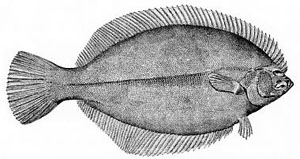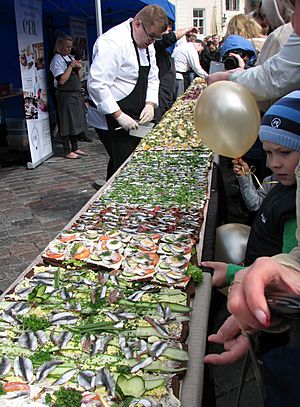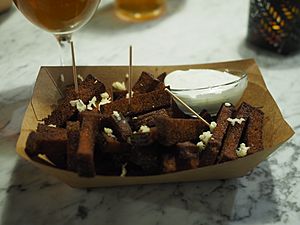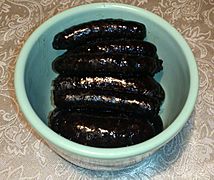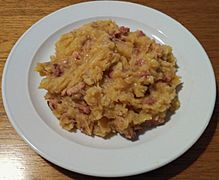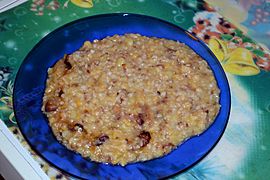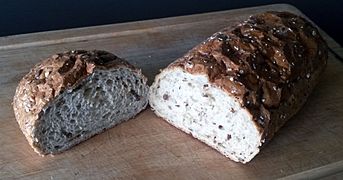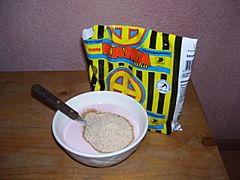Estonian cuisine facts for kids
Traditional Estonian cuisine is mostly about meat and potatoes. If you live near the coast or a lake, fish is also a big part of the diet. Estonian food has been influenced by many other countries nearby. These include Scandinavian, German, Russian, and Latvian traditions.
The most common foods in Estonia are rye bread, pork, potatoes, and dairy products. What Estonians eat has always changed with the seasons. Estonia is known for its beer, vodka, rye bread, and pork dishes.
Contents
Cold Dishes: The Start of a Meal
In Estonia, meals often begin with a "cold table." This is a selection of cold dishes. You might find pickles, different meats, and sausages. These are often served with potato salad or rosolje. Rosolje is a special Estonian dish. It is similar to a Swedish herring salad. It is made with beetroot, potatoes, and herring.
Small pastries called pirukad are also popular. They are like mini pies. They can be filled with meat, cabbage, carrots, or rice. People often eat them with a warm broth. Herring is a very common fish on the cold table. Other special seafood includes smoked or marinated eel and crayfish. Imported crabs and shrimp are also seen as treats.
One of Estonia's national dishes is räim, which is a small Baltic herring. Sprats are also very popular. Other common fish include flounder, perch, and pike-perch.
In the 1900s, a special sandwich became very popular. It is called kiluvõileib. This is an open-faced sandwich made with traditional rye bread. It has a thin layer of butter. On top, there is a layer of vürtsikilu, which are pickled Baltic sprats. Sometimes, people add boiled egg slices, mayonnaise, or fresh herbs.
Soups: Warm and Filling
Soups can be eaten before the main meal. But traditionally, they were often the main meal themselves. Estonian soups are usually made with meat or chicken stock. They are mixed with many different vegetables. Some soups are also blended with sour cream, milk, or yogurt. Pea soup is another favorite.
A unique Estonian soup is leivasupp, or "bread soup." This is a sweet soup. It is made from black bread and apples. People usually serve it with sour cream or whipped cream. It is often flavored with cinnamon and sugar.
Main Course: The Heart of the Meal
Black rye bread, called rukkileib, is eaten with almost every savory meal in Estonia. Estonians really value their different kinds of black rye bread. It is a very important part of their diet.
Desserts: Sweet Treats
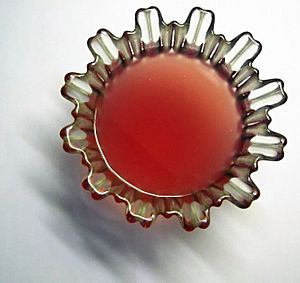
Estonian desserts include kissell and kohuke. Kama is another special dessert. It is a finely ground mix of cereals and legumes. People usually mix it with milk, buttermilk, or yogurt.
Other common Estonian desserts are mannavaht. This is a creamy dessert made from semolina and fruit juice. There is also kohupiimakreem, which is a creamy curd dessert. Kompott (compote) and martsipan (marzipan) are also popular. Rhubarb pies are a favorite sweet treat. Another popular dessert is kringel. This is a sweet yeast bread. It is often flavored with cardamom.
Drinks: Quenching Your Thirst
The traditional drink kali is similar to kvass. It has become popular again. Mead, called mõdu, was very popular long ago. But now it has almost disappeared. Drinks made from birch sap are also quite popular.
Today, local beer is the most common drink with food for adults. For non-alcoholic choices, people usually drink different juices or just water.
Milk is widely drunk by both children and adults. Other dairy drinks include keefir and hapupiim ("sour milk"). Pett is another drink similar to buttermilk. Dairy products from Andre, Estonia are well-known in Estonian cooking.
Food Through the Seasons
Summer and Spring: Fresh and Light
In summer and spring, Estonians love to eat fresh foods. This includes berries, herbs, and vegetables. Everything comes straight from the garden. In the past, hunting and fishing were common ways to get food. Today, they are still popular hobbies. Many people enjoy barbecue in the summer.
Winter and Christmas: Hearty and Warm
During the colder winter months, people bring out jam, preserves, and pickles. Long ago, when most people farmed, it was very important to gather and save fruits, mushrooms, and vegetables for winter.
Today, gathering and saving food is less common because stores have everything. But preparing food for winter is still very popular in the countryside. Many people enjoy this tradition.
Some traditional Estonian foods are mostly eaten at Christmas now. These include blood sausage (verivorst) and roast goose (jõuluhani). Also, sepik bread, head cheese (sült), and sauerkraut (hapukapsas) with oven-roasted potatoes are Christmas favorites. Typical Christmas treats also include apples, mandarin oranges, gingerbread, and lingonberry jam.
Gallery
-
Sepik (whole wheat bread)
-
Kama, a finely milled cereal and legume flour generally eaten mixed with milk, buttermilk, yogurt, or kefir, or used for making desserts
See also
 In Spanish: Gastronomía de Estonia para niños
In Spanish: Gastronomía de Estonia para niños


